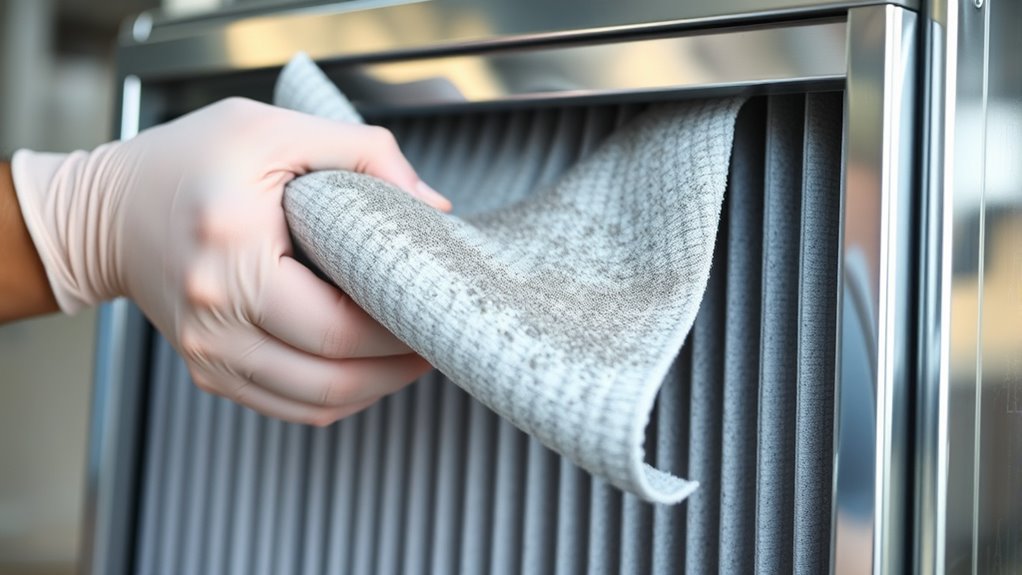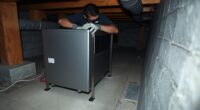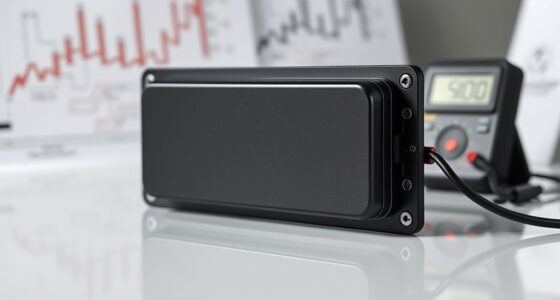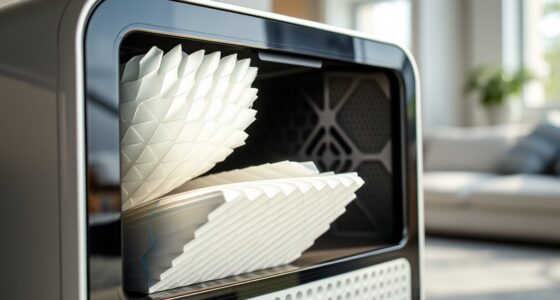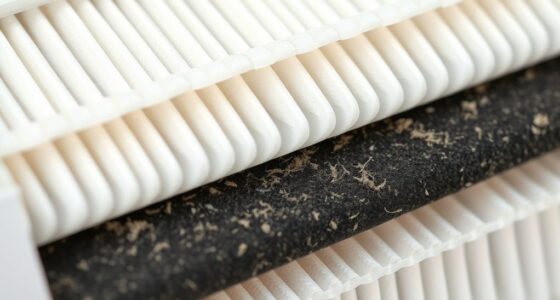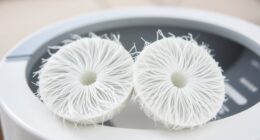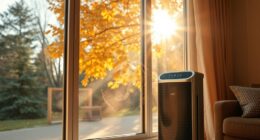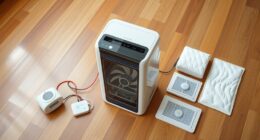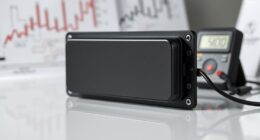To prolong HEPA performance, regularly clean your pre-filters using gentle methods suited to their type. For washable filters, rinse with water and mild detergent, then let them dry completely before reinstalling. For reusable filters, use compressed air or a soft brush vacuum to remove dust and debris. Replace disposable pre-filters once they’re too dirty to clean. Maintaining consistent cleaning routines helps keep airflow high and prevents filter clogging—keep going to discover more tips.
Key Takeaways
- Use gentle cleaning methods like compressed air or soft brushes for washable pre-filters.
- Rinse washable filters with water and mild detergent, then dry completely before reinstallation.
- Replace disposable filters once they become too dirty or clogged; avoid cleaning and reusing.
- Schedule regular inspections based on environmental dust levels to prevent debris buildup.
- Follow manufacturer guidelines to prevent damage and ensure optimal airflow and filter lifespan.
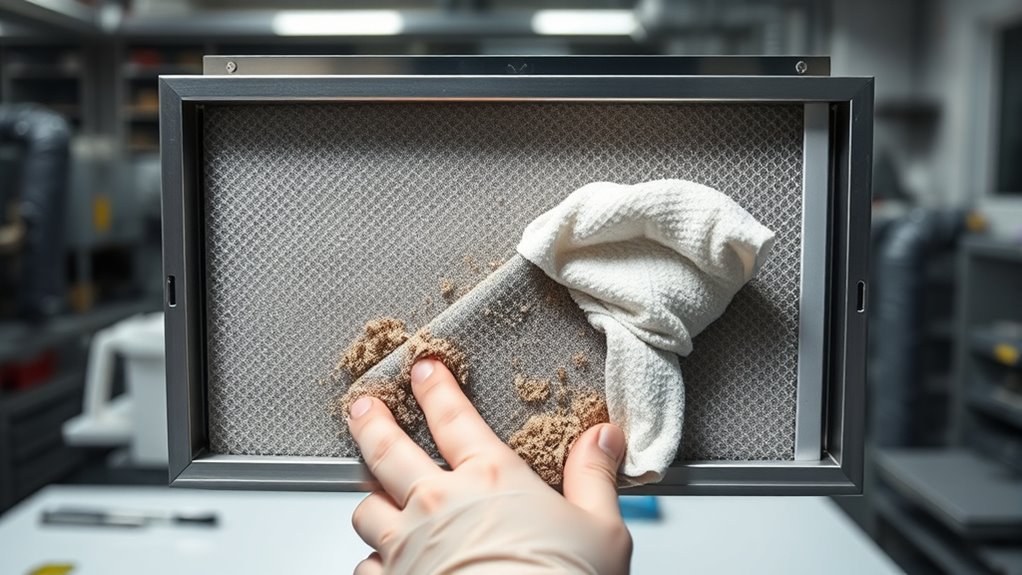
Have you ever wondered how to keep your pre-filters performing their best? Proper maintenance is essential to maximize airflow efficiency and extend the filter lifespan. When pre-filters are clean and functioning well, they allow air to flow smoothly through your system, reducing strain on your HEPA filters and improving overall air quality. Neglecting pre-filter cleaning can lead to clogging, which hampers airflow and causes your HVAC system to work harder, increasing energy consumption and wear. To prevent this, regular inspection and cleaning are key.
Regular pre-filter maintenance keeps airflow smooth and prolongs filter life.
Start by checking your pre-filters frequently, especially if your environment is dusty or polluted. When they become visibly dirty or clogged, it’s time to clean them. Avoid waiting until airflow drops considerably or your system indicates a problem. Consistent cleaning not only maintains ideal airflow but also prolongs your filters’ lifespan by preventing debris buildup that can damage or shorten their effectiveness. Remember, the goal is to keep the pre-filters as free of particles as possible to ensure smooth airflow and consistent filtration performance. Additionally, understanding filter maintenance best practices can help you optimize the lifespan of your entire air filtration system.
Cleaning techniques vary based on the type of pre-filter you use, but generally, gentle methods are best. For washable or reusable filters, use compressed air or a vacuum with a soft brush attachment to remove dust and debris. If the filter is washable, rinse it with water and mild detergent, then let it dry completely before reinstalling. Avoid harsh chemicals or aggressive scrubbing, as these can damage the filter media and reduce its effectiveness. For disposable filters, simply replace them once they become too dirty or clogged; do not attempt to clean or reuse them, as this can compromise their filtering capabilities.
Implementing a routine cleaning schedule helps maintain consistent airflow efficiency and prevents dirt from accumulating over time. Keep in mind that the frequency of cleaning depends on your environment—more frequent cleaning may be necessary in high-dust areas. Properly maintained pre-filters reduce strain on your main HEPA filters, which greatly enhances their lifespan and performance. This proactive approach minimizes the risk of system failure and ensures you’re breathing cleaner, healthier air.
Frequently Asked Questions
Can Pre-Filters Be Cleaned With Water Without Damage?
You can clean pre-filters with water, but you need to do it carefully to avoid filter damage. Gently rinse the filter to remove dust and dirt, avoiding harsh scrubbing or high-pressure water, which can cause damage. Make sure the filter is completely dry before reinstalling it, as moisture can lead to mold or reduced filtration efficiency. Proper water cleaning can help extend the filter’s lifespan without causing damage.
How Often Should Pre-Filters Be Inspected for Cleaning?
Imagine your air purifier as a vigilant guardian, constantly battling dust and debris. You should inspect your pre-filters at least once a month to catch buildup early. Stick to regular cleaning schedules to prevent clogging and maintain ideal HEPA performance. Regular inspections allow you to spot dirt before it hampers airflow, ensuring your air stays clean and fresh. Keep your filter’s shield strong by checking it often!
Are There Eco-Friendly Cleaning Options for Pre-Filters?
Yes, there are eco-friendly cleaning options for pre-filters. You can use biodegradable solutions and natural cleaning agents like vinegar, baking soda, or plant-based cleaners to clean your filters effectively. These options reduce environmental impact and avoid harsh chemicals. Just make certain you thoroughly rinse and dry the filters before reinstalling to maintain their performance and prolong their lifespan while caring for the environment.
What Signs Indicate a Pre-Filter Needs Replacement Instead of Cleaning?
You should replace your pre-filter when you notice excessive dust buildup that cleaning can’t remove or if there’s persistent odor development despite cleaning. If the filter looks visibly damaged, warped, or clogged with debris, it’s time for a replacement. These signs indicate the filter’s effectiveness has diminished, and continuing to clean won’t restore its performance. Replacing guarantees ideal airflow and maintains your HEPA filter’s efficiency.
Does Cleaning Pre-Filters Affect Overall HEPA Filter Lifespan?
Imagine your filter as a shield guarding clean air—cleaning pre-filters helps maintain HEPA efficiency, but overdoing it can weaken that shield. When you clean pre-filters properly, you prolong their lifespan and support overall HEPA filter performance. However, frequent or improper cleaning may cause damage, reducing the HEPA filter’s effectiveness and lifespan. So, focus on correct pre filter maintenance to keep your air purifier working preferably longer.
Conclusion
By regularly cleaning your pre-filters, you keep your HEPA system working like a breath of fresh mountain air. Imagine the filters as a gentle sieve, catching dust and allergens before they reach your lungs. When you maintain them, it’s like giving your indoor air a crisp, clear stream to flow through. Keep those filters clean, and enjoy a home filled with pure, revitalizing air—invigorating as a spring morning, every single day.
